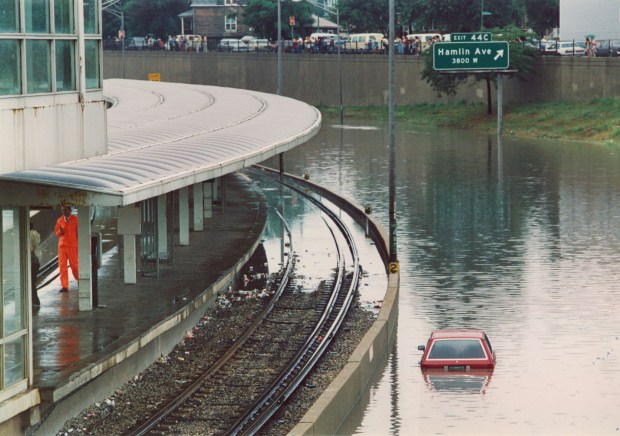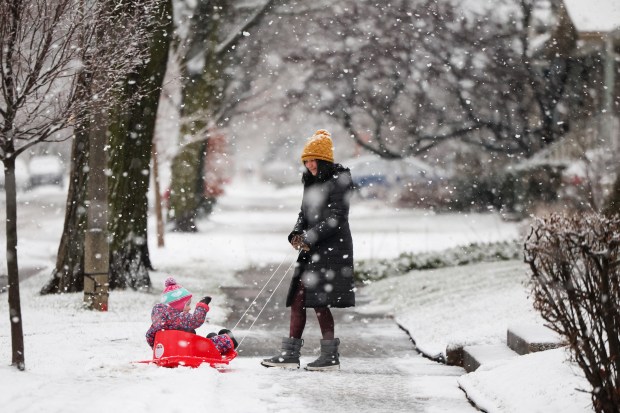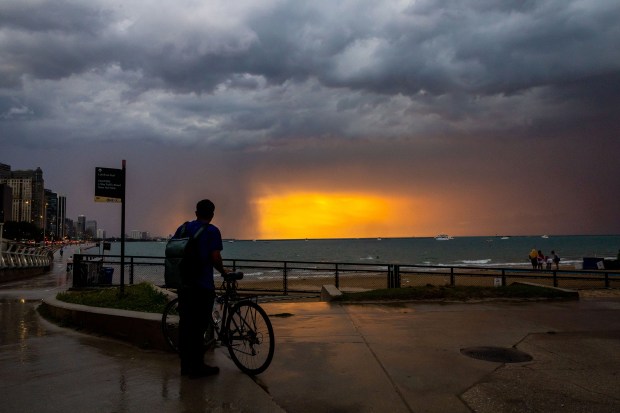Weather in and around the city this year will be remembered for being warmer than average, but not without its quirks.
Chicago experienced bitter cold temperatures in mid-January, but overall winter 2023-24 was one of the warmest on record. Severe thunderstorms and a derecho struck the area this past summer as hot, humid days lingered. On July 15, the National Weather Service issued 16 tornado warnings — the most the agency sent out in a single day — since 2004.
Here’s a look at the most extreme days in Chicago weather this year.
Hottest: 99 degrees (Aug. 27, 2024)
At O’Hare International Airport, the temperature reached 99 degrees, breaking the record high for Aug. 27, which was originally set in 1973. A century-old record low temperature was also broken — a hot and humid 79 degrees. The temperatures led Metra to implement “hot weather speed restrictions,” lowering train speed by 10 miles per hour.
Photos: Storms roll through the Chicago area following excessive heat warning
Concerns for homeless people, elderly and those with preexisting conditions grew as sweltering temperatures and heightened pollution levels gripped the Chicago region, leading to hazardous conditions for vulnerable populations, according to the National Weather Service.
Aug. 27 was one of 23 days this year when the high temperature reached 90 degrees or hotter, yet no 100-degree days were observed.
How it compares historically
Sweltering summer nights are the most compelling evidence of climate change in the Midwest, experts say.
Overall summer average temperatures have increased by 1.5 degrees between 1970 and 2022 in Chicago, but average lows have warmed at a higher rate of 2.2 degrees in that same time. A possible effect of climate change? Illinois’ corn is becoming more sweaty.
Yet when looking through more than 136 years of data kept by the weather service, Chicago has logged triple-digit temperatures only 66 times.
Chicago experienced its first 100-degree day in more than a decade on Aug. 24, 2023.
The highest temperature on record in Chicago was 105 degrees logged on July 24, 1934, but unofficial results have been even more extreme. Documented highs of 109 degrees during the Dust Bowl in 1934 and 106 during an oppressive heat wave in 1995 were set at other sites in the city.
Photos: The best images of 2024 by Chicago Tribune photographers
Coldest: Minus 10 degrees (Jan. 14-15, 2024)

From Jan. 14-17, the polar vortex returned to Chicago, bringing wind chills of minus 30 degrees to the area, according to the National Weather Service. The freezing air mass was the coldest Chicago had seen in five years, with the last comparable cold snap in January 2019. That previous stretch of frigid conditions produced the state’s coldest temperature ever — minus 38 degrees in Mount Carroll, which sits west of Chicago.
But the subzero temperatures did not faze Dan O’Conor — otherwise known as the “Great Lake Jumper” —who continued his daily ritual of leaping into Lake Michigan.
How it compares historically
It’s been much colder.
Eight of the coldest temperatures and seven of the largest snowfalls ever recorded here happened in January.
The city experienced a day of frostbite, fuming motorists and freezing homes on Jan. 20, 1985, when the temperature plummeted to minus 27 degrees — the coldest day on record in Chicago.
Tom Skilling, WGN-TV’s former chief meteorologist, who retired at the end of February 2023, remembered the time he had to push his car into a garage behind the station to warm it up during one brutally cold winter.
“They used to do Bert Weinman Ford commercials in that garage so they had a big turntable that they put the cars on as the announcer told you about the latest deal. Well, that’s the same garage into which we pushed my car and after a couple of hours, I could finally get it going again. But, oh, it was just awful!
“The atmosphere took on a very almost unworldly state at that point,” Skilling told the Tribune.
Wettest: 1.64 inches (July 14, 2024)

The rain total didn’t capture the scope of the severe weather that rolled through Chicago beginning overnight July 14 and continuing into July 15. The area experienced 16 confirmed tornadoes and a rare derecho event, or long-lasting thunderstorm with high winds that can cause damage similar to a tornado, Ted Berger, executive director of the Cook County Department of Emergency Management and Regional Security, said in August when President Joe Biden approved a disaster declaration and directed federal assistance to support recovery efforts in areas affected by severe storms and flooding.
Biden’s declaration, which came after Cook County and Illinois made similar disaster proclamations, allowed the Federal Emergency Management Agency to offer individual assistance to residents in areas hardest hit by the July storms, including Cook, Fulton, Henry, St. Clair, Washington, Will and Winnebago counties.
Over a month after the storms, many suburban communities hit hardest, including Harvey, Dolton, Flossmoor and Robbins, were still dealing with the aftermath, which at the time left thousands without power along with debris, fallen trees, broken glass and other property damage.
How it compares historically

Aug. 14, 1987: Looking North on the Kennedy Expressway from Addison Street at 11 a.m. Several cars were underwater, as well as semitrucks. The expressway was closed down.
Chicago’s heaviest rainfall on record at O’Hare for a 24-hour span was 9.35 inches on Aug. 13-14, 1987. If that rain had been snow, according to the National Weather Service, then Chicago and its north suburbs would have been buried under 93 inches, or about as much as during the entire infamous winter of 1979, when it took several weeks to accumulate that amount.
The landmark rainfall from 1987 made it easier to get to O’Hare from Los Angeles than from downtown Chicago. The trip from the West Coast took only about four hours; the trip from downtown Chicago took 9 hours, 15 minutes for a Westin Hotel bus, according to the Tribune’s archives.
Normally, Chicago gets 3.71 inches of rain during the month of July.
Snowiest: 2.8 inches (Jan. 9, 2024)

Due to a strong El Niño, scientists predicted that Chicago’s winter would be milder and drier than normal.
Yet this storm dumped 4 to 8 inches of snow west of the city and left south and southwest suburbs cleaning up days later, according to the National Weather Service.
With winds of up to 40 mph overnight, several people took advantage of the powerful gusts to take to the surging waves on Lake Michigan. A couple of dozen people surfed on Greenwood Beach in Evanston in the early morning hours, where waves were up to nearly 8 feet and surfers remarked on “a warm day” out on the water.
“You don’t have to worry about jellyfish. You don’t have to worry about sharks. You don’t have to worry about the salt, those are the benefits but adjusting to the cold temperatures and unpredictable surf can be hard,” said Lee Remias of Winnetka as he was left the beach.
How it compares historically
Chicago’s largest single snow event began with flakes falling at 5:02 a.m. on Jan. 26, 1967, and didn’t stop until a record-breaking 23 inches had accumulated the next day. Mountains of snow accumulated in drifts, whipped by winds of 50 mph or more.
Many commuters were stuck at their workplaces on Jan. 26 as a result of the snow, staying there or at a nearby hotel for the night.
In Chicago alone, an estimated 20,000 cars and 1,100 Chicago Transit Authority buses were stranded in the snow, according to the weather service. More than 2,500 people and 500 pieces of equipment would be used in the ensuing days to dig out the roads. The airports were also closed and passengers stuck inside terminals were provided pillows, blankets and hot coffee as crews outside worked to clear runways.
Remarkably, the storm was preceded by unseasonable warmth — it was 65 degrees just two days before the snow appeared.
The most snow Chicago has ever received in one season is 89.7 inches during 1978-79. The least — 9.8 inches — occurred in 1920-21.
Sources: Tribune reporting and archives; National Weather Service Chicago
Join our Chicagoland history Facebook group and subscribe to the Vintage Chicago Tribune newsletter for more from Chicago’s past.




